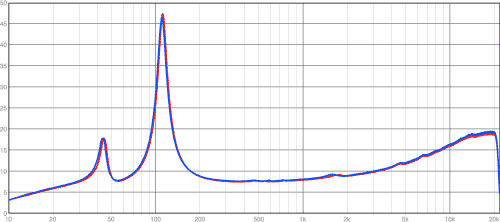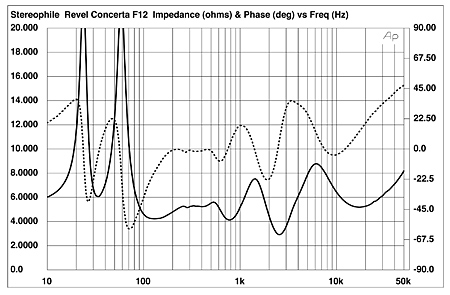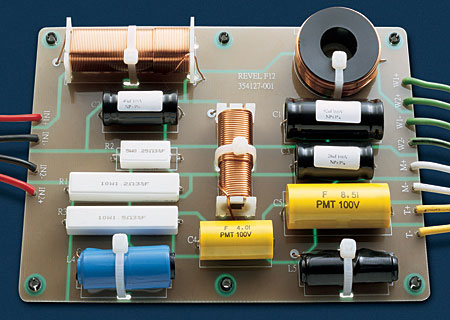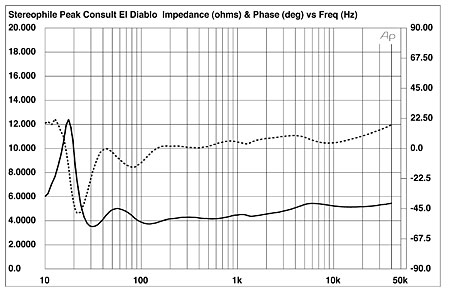When shopping for speakers, for example, you can simply push the cone (unless it's ceramic, naturally) and see how far it goes to find out Xmax
I hope I don't seem relentlessly argumentative, but this is not how to measure Xmax. Xmax, which was not originally defined as a T/S parameter, has been abused through the years by marketing departments, but a rigorous definition has become widely accepted in recent years. Xmax is related to length of the magnetic gap compared to the voice coil height, whether underhung or overhung. In other words, when the voice coil leaves the magnetic gap, it runs out of linear magnetic force, and that point of departure is Xmax. Eminence defines Xmax as voice coil height minus top plate thickness, divided by two. Most speakers can be mechanically "pushed" considerably beyond Xmax. The suspension throw (sometimes called Xmech) is usually significantly larger than Xmax in order for suspension non-linearities not to be a huge factor within the linear magnetic Xmax range. Sure, a speaker with Xmax = 25mm will probably have a larger mechanical suspension throw than one with Xmax = 5mm, but again the connection is too indirect to be useful for speaker shoppers. And most retailers would frown on shoppers pushing in speakers cones anyway. By the way, I see no reason that a ceramic speaker cone would resist your push test any more than a paper cone. You’re not trying to bend the cone itself, just the soft suspension, which a ceramic cone must have too.
Yes, Pass' experiments happened to be with full-range speakers, but I was referring to the fleshing out of the bass region due to impedance interactions, and that applies to multi-way or full-range speakers alike, whenever a speaker is in a box.
The “proof is in the pudding”. Driver and box parameters such as Xmax, B, l, Cms, Mms, Re, Le, Rms, Sd, Qes, Qms, etc., all play into determining the final speaker SYSTEM performance, but since speaker system manufacturers rarely tell you these things, you have to look instead at the end performance results of these parameters: the aforementioned impedance curves, response curves, sensitivity rating, etc. These more relevant parameters are often available, either from the speaker system manufacturer (due skepticism allowed) or via magazine tests. While these performance results may not tell you whether a speaker will sound any good, they might give a useful clue as to whether or not the speaker system is a good candidate for high-Z, low-power tube amps – and I think that’s what the original poster was asking us for.
Brian Beck said:I hope I don't seem relentlessly argumentative, but this is not how to measure Xmax.
I was offering a shopping tip (clue: "When shopping for speakers...") when I recommended pressing the speaker cone to get an idea of its Xmax value. I'm sorry, it just didn't cross my mind that it would be construed as a method for measuring Xmax with any scientific accuracy and rigour.
Xmax, which was not originally defined as a T/S parameter, has been abused through the years by marketing departments, but a rigorous definition has become widely accepted in recent years. Xmax is related to length of the magnetic gap compared to the voice coil height, whether underhung or overhung. In other words, when the voice coil leaves the magnetic gap, it runs out of linear magnetic force, and that point of departure is Xmax. Eminence defines Xmax as voice coil height minus top plate thickness, divided by two.
Let's not overcomplicate things. Vance Dickason in The Loudspeaker Design Cookbook explained how to measure Xmax in a quite simple and articulate manner. Still, from my experience, the best way to do it is to measure the function x=f(i).
Most speakers can be mechanically "pushed" considerably beyond Xmax. The suspension throw (sometimes called Xmech) is usually significantly larger than Xmax in order for suspension non-linearities not to be a huge factor within the linear magnetic Xmax range...
.. And most retailers would frown on shoppers pushing in speakers cones anyway.
Let me assure you that my push test is accurate enough to be of use to our average speaker shopper. Just for the purpose of this argument, I took 2 woofers that happened to be laying around (JBL 123-A, underhung, and ScanSpeak 15W/8530K0, overhung), pressed their cones as far as they would go and measured the excursion. Guess what; the rated linear excursion published by the manufacturers (Xmax) was only 1mm less than what I got - in both cases! I'd be curious to learn what kind of evidence do you have to support the claim that most speakers can be mechanically pushed considerably beyond Xmax and that the suspension throw is usually significantly larger than Xmax? From my experience and the research I've done, that's simply not true.
BTW, I do this sort of "poking" all the time and I've had no problems so far with retailers over here; they usually keep "display-only" units intended for such "abusive" types like myself. As long as you handle the unit gently and carefully, they don't seem to mind at all.
By the way, I see no reason that a ceramic speaker cone would resist your push test any more than a paper cone. You’re not trying to bend the cone itself, just the soft suspension, which a ceramic cone must have too.
Remember Accuton drivers? Their designers had to throw in some protection grills because the application of even the slightest non-concentrical force can cause the fragile cones to break to pieces. It's not that a ceramic speaker would resist my push test but quite the contrary - it might break so it'd be best to avoid touching it at all. That's what I meant.
Yes, Pass' experiments happened to be with full-range speakers...
Nelson's experiments have nothing to do with what we're discussing here.
Driver and box parameters such as Xmax, B, l, Cms, Mms, Re, Le, Rms, Sd, Qes, Qms, etc....
BL=f(x), Le=f(x), Cms=f(x). All these parameters change when the position of the cone changes. The larger the movement of the cone from its rest position, the larger the change! These changes have a direct impact on woofer distortion levels. As a general rule, woofer distortion levels are higher for higher X values, which means that we need to get Xmax as low as possible (i.e. reduce the cone movement as much as possible) for a given acoustical power/sensitivity.
From the following formulae
Par=Kp*(f3^4)*(Vd^2)
and
Vd=Sd*Xmax
it follows that if Kp and f3 are constant, we can get the power we need by adjusting Sd (cone area) and Xmax. If Xmax is to be kept low, then Sd must be sufficiently increased. A small max. cone movement also positively reflects on other speaker characteristics, such as impulse response, nonlinear distortion, surround damping, back EMF, etc.
...all play into determining the final speaker SYSTEM performance, but since speaker system manufacturers rarely tell you these things, you have to look instead at the end performance results of these parameters: the aforementioned impedance curves, response curves, sensitivity rating, etc.
Impedance curves would be relevant if they consisted of the resistive component only. But, this is not the case and impedance is a complex thing that includes the reactive component as well, so it can tells us very little about what to expect from the interaction between the tube amp and the speaker.
The response curve of the speaker is anyway influenced by the listening room more than anything else. Besides, it tells us nothing about how it was achieved and what compensation and tuning methods may have been applied.
These more relevant parameters are often available, either from the speaker system manufacturer (due skepticism allowed) or via magazine tests...
As I said earlier, I am of the opinion that these are not relevant parameters in this particular case (not in general) and cannot give us a clue as to how the tube amp - speaker combination will work in practice.
Regards,
Milan
I think I've already explained well enough why pushing in woofer cones is not the best advice to give a person shopping for a speaker for his tube amp. I hope the original poster got what he needed and was not confused by this "excursion". In the interest of time, I rest my case with what I've already said.
I hope the original poster got what he needed and was not confused by this "excursion".
Well, I think the discussion went a little over my head, but I think i've gleaned the info I need. Thanks all.
Why is this? It seems that my speakers have a gentle impedance bump at 70 Hz. The higher supply voltage allows the amp to work into this higher reflected load impedance without clipping.
This post also helps explain:
http://www.diyaudio.com/forums/showthread.php?postid=460497#post460497
This post also helps explain:
I understand the reflected impedance scenario. I had been playing with different transformers on my test amp, and discovered that a 3K ohm transformer gave better sound than the 5K ohm transformer which tested better on the bench.
After I wrote the preceding post I found the impedance VS frequency curves for my speakers. This is NOT what you would call a tube friendly speaker.
The curves can be seen here:
http://www2.yamaha.co.jp/manual/pdf/pa/english/speakers/NS10MSTUDIOE.pdf
At the frequency of the bass guitar tracks shown in the previous post, the speaker is over 20 ohms. This is how I can get 35 volts peak to peak across an "8 ohm" speaker from a trioded EL-34. The EL-34 was seeing a load of approximately 7.5 K ohm and with 420 volts to work with, it was just loafing along. When I put a resistive load on the amp which gave the tube a real 3K load is was starved for current, and distorted above 4.5 watts.
This is a case of tweaking the amp to match the speakers.
couldn't you just give the tube amp better dampening and have it work with any speaker? it's pretty dumb to make tube amps that is only able to work with a few speakers.
cotdt said:couldn't you just give the tube amp better dampening and have it work with any speaker?
There is no such thing as an amp that works with any speaker. A speaker & an amp should always be considered as a system. In some case we want an amp with low damping (damping is a terrible term since it only has meaning with a speakers (varying) impedance in the equation -- output impedance is much more meaningful to talk about)
dave
cotdt said:couldn't you just give the tube amp better dampening and have it work with any speaker? it's pretty dumb to make tube amps that is only able to work with a few speakers.
"System made of optimal components can not be optimal" (C)
Also take a look here ...it's about efficiency
http://www.stereophile.com/loudspeakerreviews/272/index5.html
http://www.stereophile.com/loudspeakerreviews/272/index5.html
yagas said:Also take a look here ...it's about efficiency
http://www.stereophile.com/loudspeakerreviews/272/index5.html
No, it is about wrong measurements (voltage VS power)
yagas said:Also take a look here ...it's about efficiency
http://www.stereophile.com/loudspeakerreviews/272/index5.html
If you read between the lines, they are assumming a constant voltage amp... ie one with a low output impedance, so when dealing with high output impedance amps (amps that tend toward constant current) one has to take their slant with a grain of salt.
dave
efficiency is not a factor unless you listen to music loudly. if you sit right in front of your speakers, it will get plenty loud.
Peter M. said:Some recommended guidelines from Welborne Labs :
They seem mostly concerned with the efficiency aspect -- an SE amp tends to have low power output so an efficient speaker is required to play reasonably loud.
What they don't consider is the shape of the impedance curve. If an amplifier has high output impedance as SE amps tend to have, the amplifier will deliver more power as the impedance curve rises (low damping factor enthusiasts use this fact to denigrate SE amps as variable tone controls). One needs to use this to one's advantage when completing the amp/loudspeaker system but careful choice of the loudspeaker.
If you look at the impedance curve of a typical full-range speaker (here a Fonken with Fostex FE127e):

You see that the impedance curve is a fairly smoothly with a rise on the top & one on the bottom (ignore the port tuning saddle). With a high output impedance amp it will be working harder at the top & the bottom which tends to balance the falling acoustic output of the FR driver at either end giving us a wider flat frequency response.
Amps recommended for thos speaker are those with higher output impedance, they don't work with a typically high damping factor amplifier.
Now if we look at a more typical mass market speaker with a crossover (Revel Concerta F12')

and its XO

Ignoring efficiency concerns, a high output impedance amplifier would impose FR deviations much in the shape of the impedance curve, which with this curve would wreck havoc on the midrange & top end response. This speaker assumes a constant voltage amp where it will tend to ignore the impedance swings.
Having a crossover in itself does not imply a rocky impedance curve as can be seen from this one (Peak Consult El Diablo):

dave
and that's the problem, planet10. those of us who are not fans of single-driver speakers would want lower output impedance / better dampening.
cotdt said:that's the problem, planet10. those of us who are not fans of single-driver speakers would want lower output impedance / better dampening.
That's not a problem, it just means you need to use an amplifier appropriate to your choosen speakers -- and as the last impedance chart shows, a speaker with XO can have a very flat impedance curve (just that most of them don't). Tube amps run the gamut of output impedances (just as solid state ones do)... if you want a tube amp you just need to build an appropriate one.
The original question is actually very vague & meaningless as we need to define the characteristics of the amp in question (whether SS or hollow-state). The last part of this thread has been more about matching to high-output impedance amps and applies as much to a 1st watt F2 as to a typical SE tube amp.
dave
efficiency is not a factor unless you listen to music loudly. if you sit right in front of your speakers, it will get plenty loud.
Agreed, possibly with some loss of dynamics. 2 watts and 88db/W (tube-friendly😉 ) speakers works fine for me. I live in a cardboard box.
Simon
You could always compensate the impedance to make it flat. The top end rise and crossover peaks are usually fairly straightforward to deal with. You could even go so far as to fix the bass peak despite the obvious need for large components.cotdt said:those of us who are not fans of single-driver speakers would want lower output impedance / better dampening.
After all the efficiency argument in a hifi context doesn't hold water where the impedance makes the effect frequency selective, unless the shape of the impedance curve happens to be the opposite of the shape of the response curve, which sometimes happens.
I feel it ultimately comes down to how far you're prepared to go. Building your own amp and speaker as a pair, can be very rewarding.it's pretty dumb to make tube amps that is only able to work with a few speakers.
- Status
- Not open for further replies.
- Home
- Amplifiers
- Tubes / Valves
- What makes a speaker "tube-friendly"?
